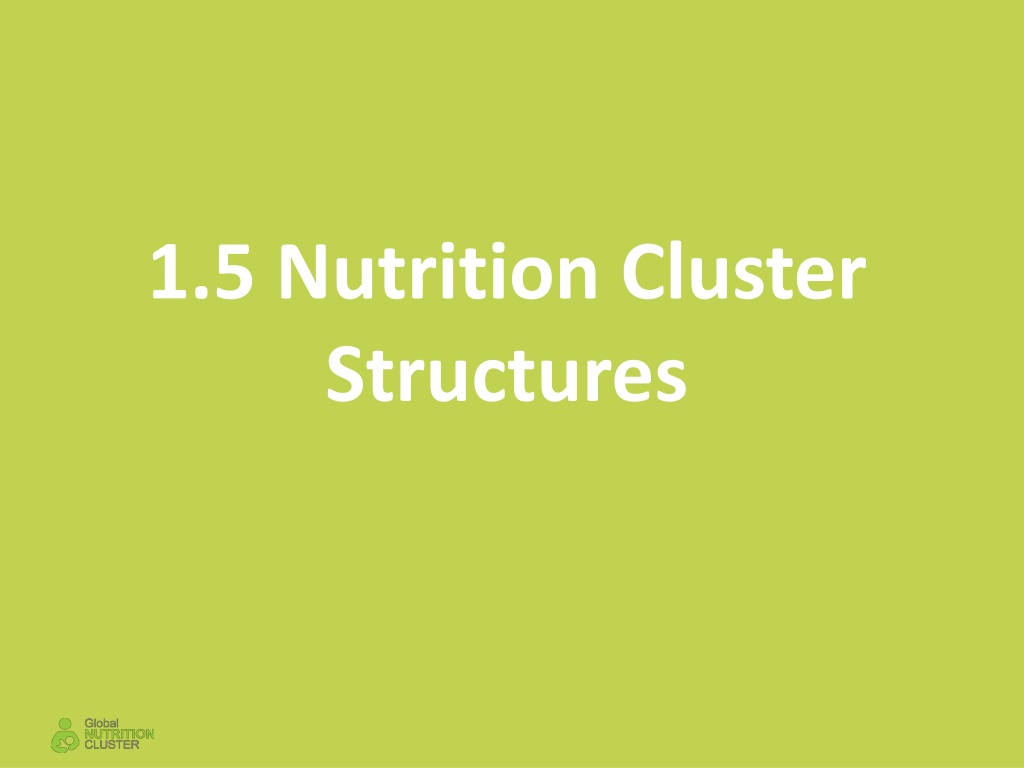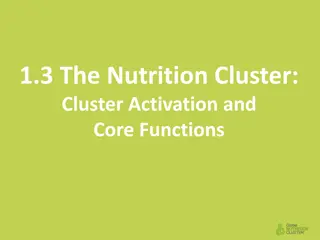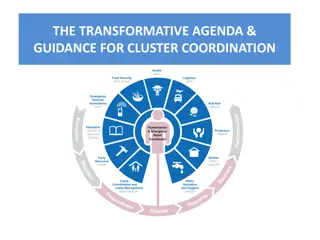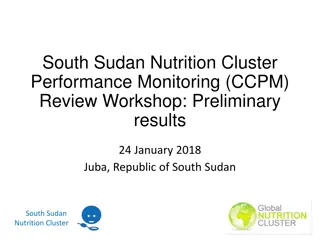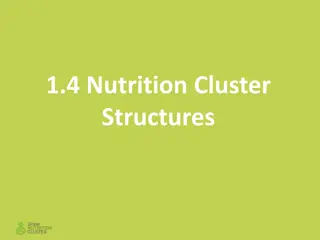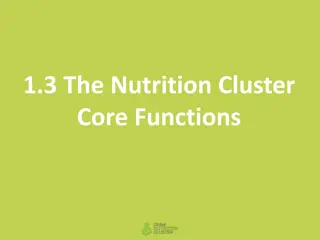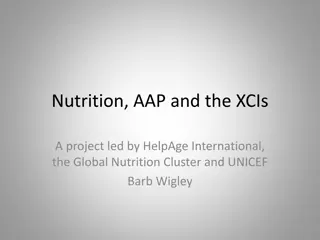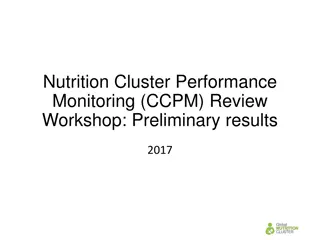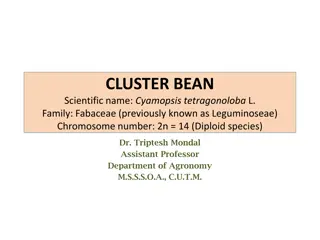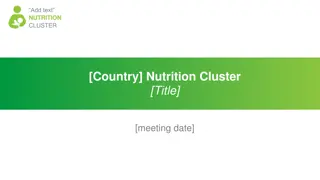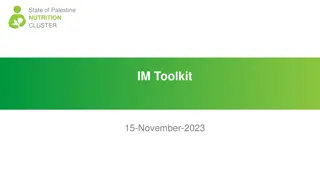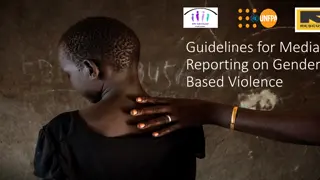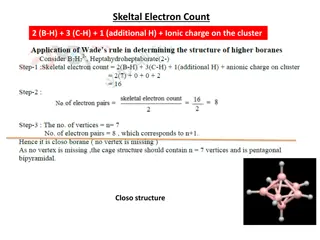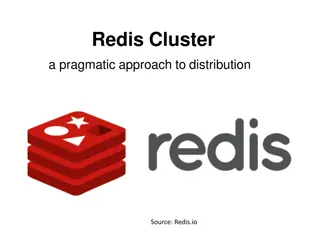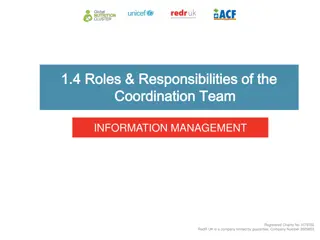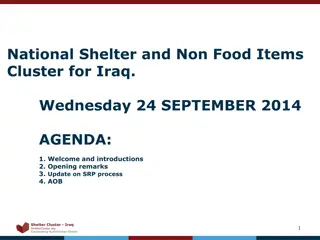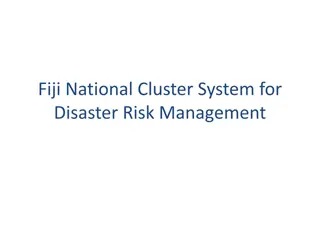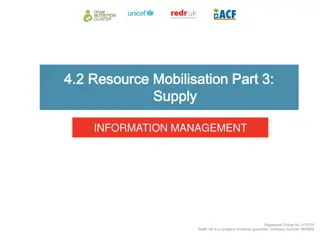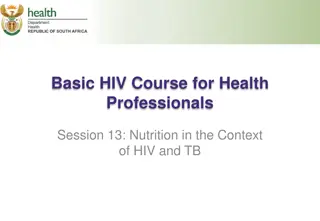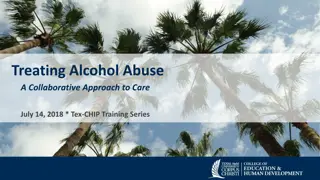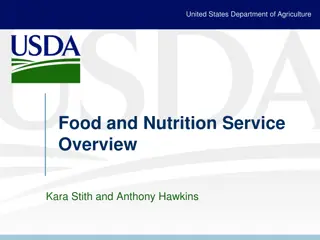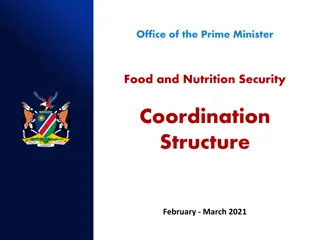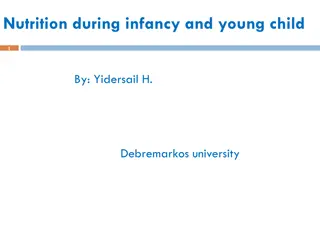Understanding Nutrition Cluster Structures and Roles
Learn about the structures and roles within Nutrition Clusters at different levels, including the responsibilities of key actors such as the Cluster Coordinator, Information Manager, Strategic Advisory Group, and Technical Working Groups. Explore the involvement of governmental and non-governmental entities in humanitarian responses, and understand the coordination teams involved in Nutrition Cluster/Sector initiatives. Discover the purpose and composition of Strategic Advisory Groups and Technical Working Groups within the cluster framework.
Download Presentation

Please find below an Image/Link to download the presentation.
The content on the website is provided AS IS for your information and personal use only. It may not be sold, licensed, or shared on other websites without obtaining consent from the author. Download presentation by click this link. If you encounter any issues during the download, it is possible that the publisher has removed the file from their server.
E N D
Presentation Transcript
1.5 Nutrition Cluster Structures
Objectives of this Session By the end of this session, participants will be able to: Identify the different structures and roles actors at different levels (global, country, sub-national, etc.) Identify the different structures and roles of the Nutrition Cluster and other actors at different levels (global, country, sub-national, etc.) Outline the responsibilities of the Cluster Coordinator and the Information Manager and the Strategic Advisory Group (SAG) and Technical Working Groups (TWiGs).
Actors in Humanitarian Response National Government OCHA HumanitarianResponse Cluster Lead Agency UN Agencies Global Nutrition Cluster Nutrition Cluster CS/C NGOs Observers
Governments role in the Nutrition Cluster/Sector? Co-lead/co-chair of the NC Or One of the NC s primary partners How is it in your country?
Nutrition Cluster/Sector Structure Nutrition Cluster or Sector Nutrition Cluster/Sector Coordination Team TwiGs SAG TwiGs TwiGs = NC Partners
Cluster/Sector Coordination Team The Cluster/Sector Coordination team provides the table around which all Cluster/Sector partners can sit down. Members ideally include: Cluster/Sector Coordinator Deputy Cluster/Sector Coordinator (could be a national staff or NGO staff member, especially in later stages) Information Manager GIS Mapping Specialist (later, a national officer) Technical Adviser (from the Cluster Lead Agency, NGO or Gov t) Executive Assistant / Secretary / Fixer (someone senior and experienced in local administration) Data Manager(s) Translator(s) 6
SAG & TWiG Strategic Advisory Groups (SAG) Technical Working Groups (TWiG) Consists of key operational partners Members nominated and elected Develops and adjusts Cluster s strategic framework, priorities and work plan. Membership represents overall Cluster partnership Enables decision-making on behalf of the larger group through representation of stakeholder groups. Is expected to interact with its broader Cluster membership to ensure a regular flow of information Are created as needed, for example to agree on minimum standards and formulate appropriate technical practices. Small, task-oriented and time-limited groups Coordinated by a focal point or technical adviser, and composed of relevant technical experts Self-selected membership TWiGs advise the SAG
Who is in SAG? Some examples: Cluster/Sector Coordinator IFRC National NGO technical experts representatives International NGO technical experts UN technical experts Government representatives 8
Nutrition Cluster in XXX Led by Co-lead- Deputy cluster coordinators Technical working groups, e.g: CMAM MIYCN, NIWG, RRM, QAAP SAG: Peer review technical team
Sub-national Coordination Cluster/Sector decentralized in zones of special importance: For example, decentralization can be necessary: If responses take place in remote areas (e.g. South Sudan) If response area is very large (e.g. DRC) If decision making needs to be decentralised Sometimes the cluster can be merged, i.e. Health and Nutrition Cluster, together on sub-national level
Cluster Accountability Frameworks
Carousel There are four flip charts in each corner with four different functions written: - Nutrition Cluster Coordinator (NCC) - Cluster Lead Agency (CLA) - Humanitarian Coordinator (HC) - Humanitarian Country Team (HCT) On each flipchart, write the responsibilities of that actor.
NCC Responsibilities Establishing andmanaging coordination on national and sub-national level Facilitating needs assessments Identification and addressing of gaps and duplications Ensuring information flow Supporting application of standards Advocacy Mobilization of resources (incl. funds) Facilitation of development of Cluster Humanitarian Response Plan Ensures monitoring NC performance Coordination Promoting quality and accountability And much more
Humanitarian Coordinator (HC) The Humanitarian Coordinator (HC) is appointed by the Secretary-General Has overall responsibility for ensuring that the international response in a particular country is: strategic well planned inclusive coordinated Effective. This includes establishing inter-sectoral coordination mechanisms, managing information and providing overall support in advocacy and resource mobilization for the response.
Humanitarian Country Team (HCT) A strategic and operational decision- making and oversight forum established and led by the HC. The HCT is responsible for agreeing on common strategic issues related to humanitarian action. Composition includes representatives from the UN, IOM, international NGOs, the Red Cross/Red Crescent Movement. 15
Cluster Lead Agency (CLA) The Cluster Lead Agency (CLA) formally commits to take on a leadership role within the international humanitarian community in a particular area/sector of activity to ensure adequate response and high standards of predictability, accountability and partnership, and to serve as a provider of last resort. 16
CLAs at Country Level CLA (UNICEF) Government with CLA as co-lead e.g. Philippines, Mali NGO lead Government with NGO as co-lead Government with CLA and NGO as co-lead e.g. South Sudan CLA with NGO as co-lead e.g. more on sub-national level
UNICEFs Responsibilities as a CLA CLA Responsibilities at the Global Level: Participate in IASC discussions Develop global partnerships Support development of policy and technical guidance Support training & operational field support Provide technical assistance to country clusters/sectors Liaise with UNICEF and other stakeholders on relevant issues
UNICEF Responsibilities as CLA What are the responsibilities of the CLA at Country Level?
UNICEFs Responsibilities as a CLA Cluster Lead Agency responsibilities at country level include: Establishing coordination mechanisms Defining clear roles and responsibilities between Cluster/Sector staff and existing Nutrition staff Covering the costs of Cluster/Sector staff Mobilizing resources on behalf of the Cluster/Sector Provider of last resort Advocating on behalf of the Cluster/Sector
CLA: Provider of Last Resort If there are critical gaps: - call on all to address these. If this fails: - may commit itself to filling gap. If funds are lacking: - mobilize resources with HC and donors. If funds are forthcoming and security/access is allowed What would this concretely mean for Nutrition?
Accountability Relationships Humanitarian Coordinator UNICEF RO and HQ UNICEF Country Rep Government Nutrition Cluster Coordinator Information Manager UNICEF Nutrition Section Chief TWiGs SAG TWiGs Nutrition Cluster Participating Agencies
Organisational Accountability What organisations are formally responsible for Is the key for an effective and efficient cluster! Formal Accountability Mutual Accountability Shared aims and collective outcomes Humanitarian actors NOT accountable to cluster leads Shared decision making Non-UN actors NOT accountable to UN agencies Open, transparent dialogue Getting the best possible results for affected people Joint responsibility Only held accountable for specific commitments Interest in regularly improving functions and coordination
Not just the Cluster Coordinators job! All cluster partners (including CLAs in their role as implementer alongside other agencies) have a shared mutual responsibility to meet the humanitarian needs of affected people in a timely, effective and appropriate manner. 26
Key Messages: The NCC has clearly defined responsibilities, as do other parts of the system (HC, HCT, etc.) All actors have specific roles that contribute to an effective and coordinated nutritional response. A management structure of strategic and working groups can help ensure they link effectively to the cluster and other actors. Keeping the focus on mutual responsibility for better results and accountability to affected people can help overcome organisational barriers towards working collectively. The cluster coordinator cannot assume sole responsibility it is a collective responsibility of all actors
